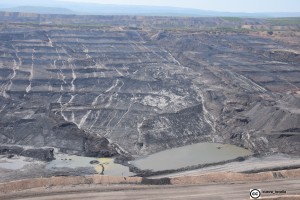This is the third and final part of the blog series «Drought and Urban Development. Click for Part I (on the U.S. Southwest) and Part II (North China Plain). Here we turn to Colombia, looking at the devastating drought that hit its Caribbean region last year.
Part III: Colombia’s Caribbean
Colombia’s Caribbean region, home to around nine million people, also faced an historic drought last year, particularly in La Guajira department. The resulting water scarcity exposed a conflict between industrial and subsistence uses of water, between coal mining and daily existence. Nearly half of La Guajira’s residents are indigenous—mostly Wayuu—and around 70% live in poverty (categories that overlap significantly). The drought killed more than 15,000 domesticated animals in the department last year, one of the main forms of subsistence for its indigenous people. The region’s inhabitants survive on an average of 0.7 L/day, far below the 50 liters daily the UN considers a minimum for a dignified life. To confront the problem, last year the IDB and Colciencias funded the construction of solar-powered wells around the city of Maicao. Projects like these are important to deal with the water crisis but it is also worth asking why there is so little water right now in La Guajira and what can be done about this problem.
Part of the explanation is the environment. The Caribbean region possesses only 8% of Colombia’s water resources and much of La Guajira is desert. Scientists predict a precipitation reduction of between 10 and 30% by 2040 in 20% of the country, particularly in the Andean and Caribbean regions. Another is El Niño, which many of the media sources covering the drought last summer pointed to as a cause. However, this seems like a limited explanation, given that 2014 was in fact a relatively weak El Niño year. The Colombian water rights group CENSAT considers blaming El Niño a concealment of more likely causes of drought and along with indigenous groups in La Guajira has singled out El Cerrejón, one of the world’s largest open-pit coalmines, as a chief cause of water pollution and waste in the region. El Cerrejón occupies approximately 69,000 hectares of land near the Venezuela border and produces around 33 million tons of coal every year, constituting 51% of La Guajira’s GDP (although only 1% of its employees are indigenous). Although many locals have testified to the gradual contamination and disappearance of rivers and streams since the arrival of the mine around thirty years ago, there unfortunately has not been sufficient empirical research to draw a causal link between coal mining and drought. In any case, pursuing extractive megaprojects as the region dries up is unwise and unsustainable.
The extraction of fossil fuels in Colombia has risen exponentially since El Cerrejón began operations in 1982. Coal titles in the country increased 87% between 2004 and 2007. According to the UNDP, if this trend continues, it will reduce the country’s renewable water resources and increase water acidity.The effects of coal mining on the water supply are many. The extraction process at El Cerrejón generates ten tons of waste for each ton of coal, uses approximately 17,000 m3 of water each day just to keep the dust on the roads from rising up, and has contaminated much of the Río Ranchería, the department’s primary river. Furthermore, coal mining generates toxic byproducts, including sulfurs and heavy metals like arsenic and mercury that dissolve and contaminate the groundwater. This water pollution creates problems for public health, food sovereignty and biodiversity. What is more, in a time of drought, it further limits the water supply. Finally, mining megaprojects have had negative social effects on the region, including the resettlement of around 7000 Wayuus. La Guajira’s social indicators remain some of the lowest in the country, despite being the third-highest recipient of royalties. Access to sewage and drinkable water is below 4% and an infant mortality rate three times the national average.
These externalities are not included in fossil fuel prices, however, creating what Mauricio Cabrera Leal and Julio Fierro Morales called an “unequal ecological exchange” and an “environmental debt” between Colombia and importing nations. Colombia is in fact the world’s fourth-largest coal exporter and El Cerrejón is one of its largest mines, accounting for 42.6% of its exports in 2011. The mine is a joint venture of the Anglo American (British), Glencore (Swiss-British), and BHP Billiton (Australian-British) mining companies, three of the worlds largest. All of El Cerrejón’s coal is for export, and in 2010, around 46% of it went to Europe. It is important to note that nearly all the EU-28 nations are net coal importers and Colombia, at 24%, is in fact the bloc’s second largest supplier after Russia. Given that around 30% of electricity in Europe is coal-powered, it is therefore likely that much of El Cerrejón’s coal goes toward electricity production. Alarmingly, as the international community attempts to set climate targets and cut emissions, economic powerhouses Germany and the U.K. have increased coal burning by 13 and 22% respectively in the past four years. Importation allows developed European countries to continue to burn coal without dealing with the environmental and social consequences that result from its extraction.
Series Conclusion
These droughts in the U.S. Southwest, the North China Plain, and in Colombia’s Caribbean are neither normal cyclical phenomena nor simple results of climate change. They, like climate change, are consequences of the way we build and sustain urban life. A growing urban population will put further strain on existing residential, agricultural, industrial and energy models and consequently on the water supply. The cracks have already appeared and the solutions discussed here—massive irrigation and diversion projects, groundwater mining, and expansion of fossil fuel markets—will only delay and exacerbate water crises.








Comentarios recientes